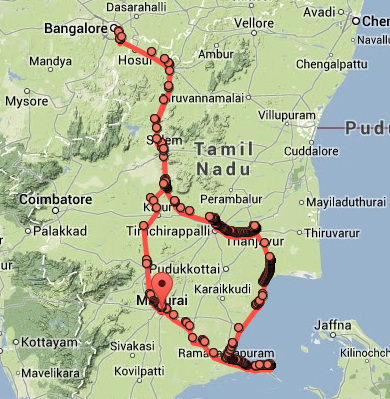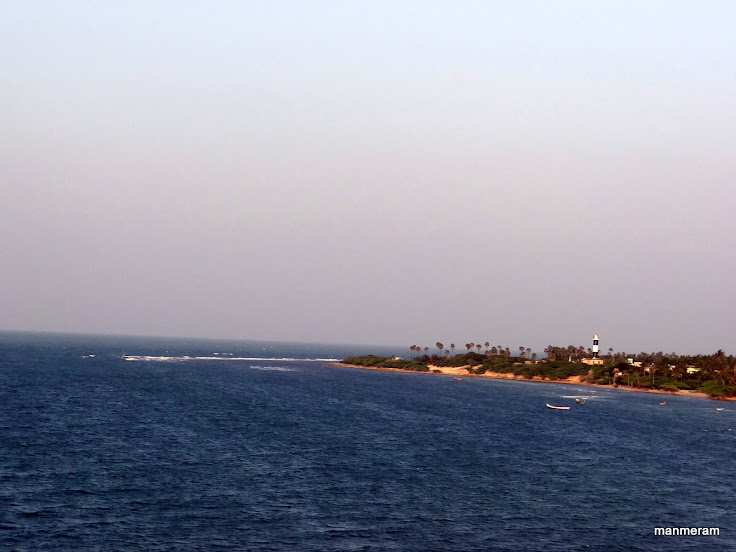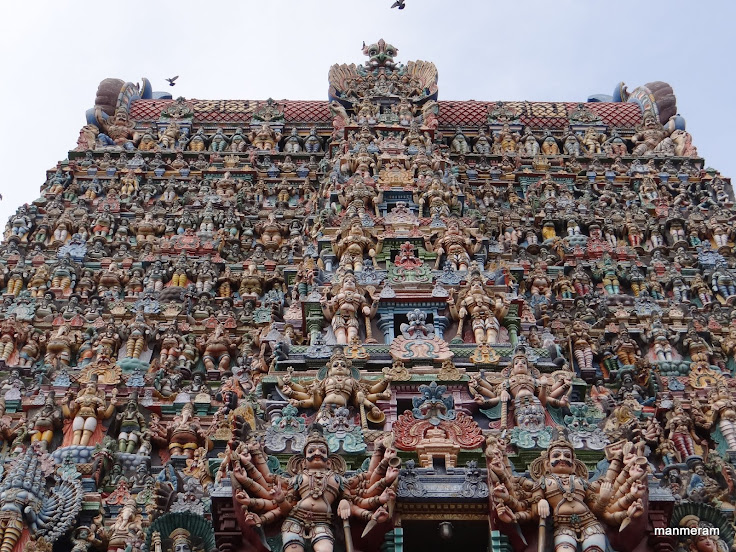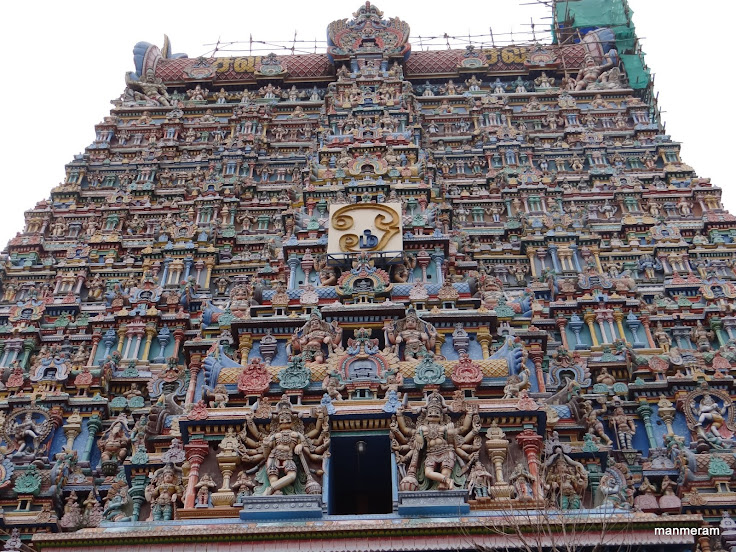After Rameshwaram, the juggernaut moved on to Thanjavur. After a restful night followed by a leisurely morning, we went to the Brihadeewaralayam, the temple of the "huge Lord". The entrance itself strikes you with amazement.
This temple that has witnessed a millennium is perhaps one of the greatest remaining sign of the prosperity both material and spiritual of India prior to the invasions. The golden yellowish color of the granite is lustrous and gives it a grand look. There is no entrance fee for this temple! You can carry your camera freely and click to your memory card's content! And boy, what grandeur!! You just can't stop admiring and clicking. See this!
 |
Obeisance to the people who made this! |
The temple is in the shape of a majestic chariot that stands 66 metres into the sky. The sculpts on the gopuram are symmetrically arranged and different from the crowded gods filled gopurams of Madurai. The symmetry makes it appear like a crystal lattice. The temple is said to have taken about 10 years to be completed, which is a very short time considering the size and detail of it. Are the rulers and builders of modern India listening?
The top bulb like structure on top is a monolith and said to weigh more than 80 tonnes! An incline plane of about 6 km long was built to push the stone to the top. There is a bit of description of the way the temple was built and about the rule of the Chola dynasty at the entrance of the temple. This temple will trump one with tradition, spur with spirituality, move with music, inspire with inscriptions and make one exclaim at its enormity. Rarely one finds a temple that is a confluence of all this. There are detailed inscriptions on the walls of the main temple which seem to have been done with an eye at posterity.
Image from Wiki
All round the temple courtyard there is a long corridor which houses more than hundred Siva lingams. These corridors have an inner sanctum which houses the Shiva lingams and a hall way.
At places one finds murals of episodes from mythology. These must have been very old and I must say they badly need a touch up. The installation of these lingams was not done by the redoubtable Raja Raja Chola but subsequently by one of the ministers.
There are Ganesha and Kartikeya temples in the courtyard. The former is said to have been built by the Marathas. Thus unlike the many temples of the northern India that got looted and destroyed by invaders, the subsequent kings of other dynasties have only added to the temple not diminished it.
After you go clockwise around the temple and walk on the corridors admiring the arrangement of numerous lingams, it is time to admire the other monolith on the campus. This is the huge bull that has been made by chiseling a 16' X 13' stone and discarding from that stone whatever was not bull! This and all the carvings here and at Madurai made me think chisel should not be far behind the wheel in terms of best invention of man since fire! The ceiling of the mandap that houses the nandi (bull) is also tastefully painted.
It is now time to enter the sanctum sanctorum of the Tanjore big temple, as it is popularly known. Unlike the many temples, the main deity, Lord Brihadeswara reveals Himself from a great distance. With a height of 3.3m, the huge lingam pygmies the priests who are offering the worship! Everything about the big temple is, you guessed it right, BIG - the Lord, the nandi, the vimanam (gopuram), the courtyard. There was a special worship on the day we visited and so we saw rice in huge plates appear like a few morsels once poured on the lingam. The Shiva lingam, ellipsoid shaped form of the formless Lord, is believed to be the microcosm which contains the macrocosm in It and so when It is propitiated, the entire universe is propitiated. In effect, this is a prayer for universal peace and welfare. If the Lord is Big, can His consort be small? Her name here is Brihannayaki! We paid our obeisance to Her. This temple is also said to have come up a few centuries later after the big one.
Tanjore big temple is a shutterbug's delight. The tall gopurams that touch the blue sky make you trail your entourage at every point. This is one place that is loved by the kids, youth, middle aged and the elderly alike. If you are a resident of Thanjavur of course you can even walk into the temple with your books and immerse yourself in that vast calm.
It was difficult to go away from here. We wanted to complete this in one hour but took three hours and still did not feel contented! But the juggernaut had to move on and so we were on our way to Srirangam, an island on the Kaveri river near Trichy, by 0230 pm. Trichy is 70 km away from Thanjavur and is connected by a national highway and so we were admiring the colorful gopuram of the Srirangam temple by 0400 pm.
Sri Ranganatha Swamy temple at Sri Rangam is an important Vaishnavite shrine. The temple is about 160 acres in extent. It is a fair bit of walk to reach the main sanctum of Sri Ranganatha swamy. The crowd was again good and so we took the route that would ensure quicker darshan. A narrow entrance leads to the main sanctum where the Lord is Sri Mahavishnu in a reclining posture on the bed formed by the serpent Adi Sesha. The idol is well decorated in true Vaishnavite tradition. It is said the first darshan every morning is had by an elephant, horse and a cow. This is known as vishwaroopa darsanam. The elephant is said to trumpet Rangaa.... This must be witnessed sometime.
Sri Rangam is also home to Sri Jambhukeswara Swamy, known to represent the water element in the Panchabhoota kshetras of Lord Shiva present between Andhra Pradesh and Tamil Nadu. We however wanted to be home by night and so could not go there.
We headed towards Namakkal from Trichy. Namakkal would complete a circle that you see below. Bangalore-Namakkal is the only road that seen twice in this journey. But unlike the Thanjavur Trichy road which is a national highway, the Trichy Namakkal stretch is a notional higway! It took almost two hours to negotiate about 80 km after which the runway greeted us and we reached Salem by 9 pm. After dinner break at Salem the journey was resumed and ended at home by 1 am.
So that was the trip in which we covered 1250 kms in 3 days, paid about a thousand rupees in toll on the highways that ensured a smooth journey. We didn't have a loaded USB stick but had a good time chatting, singing, doing bhajan and munching. The trip planning, driving, navigation was largely done with help of google maps and my wife. It is an awesome tool and the detail to which India has been mapped showed the impact of the open approach to software.
Finally, tips for a happy trip. Break whenever required. Don't compete to meet either the time estimated by google maps or to beat it. Admire every hill and river that comes your way. Drive relaxed, enjoy every moment. After all, destination is the small part in life, the bigger part is the journey itself!



























